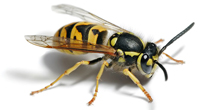Bedbugs

Why it is a pest
The close association of bed bugs with human beings means that they can cause substantial nuisance through their blood-feeding habit. They feed at night on sleeping human hosts. If the infestation is high there can be a risk of anaemia being suffered by infants, although this is rare. The nuisance and itching caused by the bites and the possibility of secondary infection is more common. Bats, chickens and other domesticated animals may also be attacked. Both male and female, adult and nymphal bedbugs take blood meals and so are equally important as nuisance pests.
There is no evidence of bedbugs being involved in the transmission of infections or diseases to humans, and they are therefore not considered to be disease vectors, however reaction to bites can be problematic with some people showing little or no reaction whereas others may suffer allergic or other severe reactions (there are some documented cases of anaphylactic shock) and sleepless nights.
The biting nuisance is not tobe underestimated, especially considering recent high profile litigation, damage to reputation and associated economic losses.
Biology of the Pest
Egg
Bed bug eggs are approximately 1mm long and 0.5mm wide, with an egg-cap (the operculum). Unhatched eggs are pearl coloured and opaque before hatching, becoming translucent when hatched. Each adult female produces around 400 - 500 eggs during its lifetime
Nymph
Nymphs are small versions of the adult form, with a thinner cuticle, which displays the colour of partly digested blood. The bed bugs increase in size from 1.3 – 5.0mm as they pass through 5 instars.
Adult
Adult bed bugs are mahogany-brown, oval, dorso-ventrally flattened, wingless insects, which are approximately 5-7 mm in length and possess piercing mouthparts. When unfed, adults are pale, yellowbrown in colour, but after a full blood meal, they take on a darker mahogany-brown colour. Three pairs of walking legs are present, slender but well developed, with efficient tarsal claws for clinging on to the host during feeding. The bed bug’s head is short and broad, with a pair of prominent compound eyes, in front of which is a pair of clearly visible 4 - segmented antennae. The proboscis is slender and normally held closely along the ventral surface of the head and prothorax. Other key points for identification are the 3 - segmented proboscis lying in a ventral groove, ocelli being absent, and the tarsi being 3 - segmented. Bed bugs are very distinctive and can usually be identified immediately.
Signs of bed bug presence
Cast nymphal skins, hatched or unhatched eggs, strawyellow, dark brown or black marks (excrement spots, consisting mainly of excess water, with a little blood) and a sickly sweet / coriander-like smell, are all signs that are used to identify bed bug presence, along with customer complaints and evidence of bites.
Removal Methods
It is a legal requirement that insects are to be identified before a pesticide treatment can take place. "The Protection of Animals Act 1911", amendment 1927. Once identified, we can use the correct pesticide/insecticide to eliminate this pest.
Whether you need help with a one-off pest removal, or are looking for regular service visits to minimise the possibility of a pest infestation causing impact on your business...
Call us on 07939964443
Prevention is better than Cure - Working with the Environment










